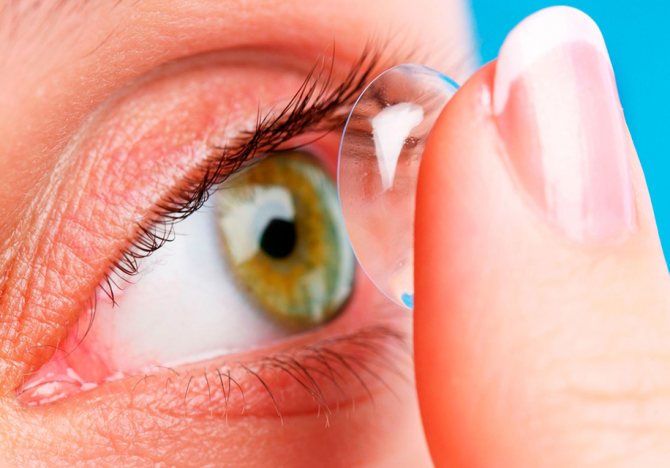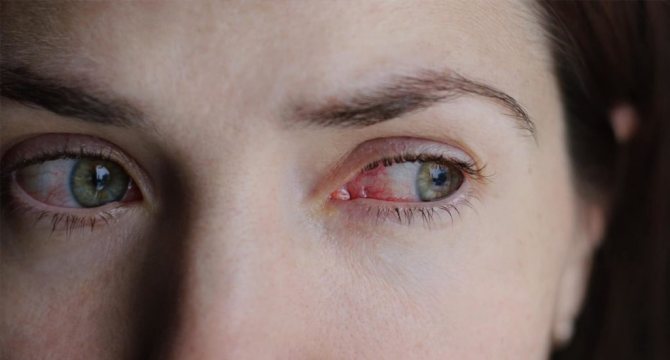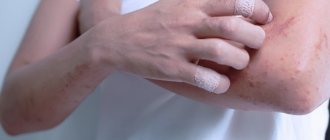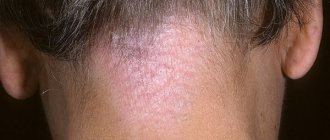If you follow the sanitary and hygienic rules for using optical instruments, various complications and allergies to lenses will not arise. Pathology can lead to interruption of wearing optics or to complete abandonment of it, which is unacceptable for doctors and patients themselves. To prevent unwanted reactions, the choice of material and product model should be entrusted to a specialist. There are several types of contact lenses (CL) - medical and cosmetic, the use of which is limited to clearly established indications and contraindications.
Can allergies occur when using contact lenses?
Many people with refractive errors wonder if there is an allergy to contact lenses, the symptoms of which include burning, redness and itching in the eyes.
This is especially true for patients with high sensitivity of the cornea. Let's consider whether these optical products can cause discomfort during use. Increasingly, patients with farsightedness, myopia and other refractive errors prefer contact correction methods. Unlike glasses, they provide high clarity not only in central, but also in peripheral (side) vision, since they are placed directly on the cornea and are located as close as possible to the eyeball. The advantages of these optical products also include practicality and ease of use. They allow you to enjoy complete freedom of movement: actively engage in sports and travel, without practically anything reminding the user of your presence. In addition, transparent models are invisible to the eye, so they do not attract the attention of others.

Many people wonder if there are allergies to contact lenses. This question is often asked by beginners who are planning to start using these optical products. It is worth noting that, as such, an allergic reaction to contact correction products is very rare. This is due to the fact that modern lenses are made from high-quality hypoallergenic materials: silicone hydrogel, hydrogel, as well as polymers with varying degrees of oxygen permeability and moisture content.
How does an allergy to contact correction products manifest itself?
- Redness of the eyes.
- Increased lacrimation.
- Photophobia.
- Itching, burning and tingling in the eyes.
- Swelling of the organs of vision.
- Painful sensations.

What drugs can be used?
The most popular medications are:
- Tavegil
is available in different variations. Relieves symptoms and fights itching. - Zodak
is an antiexudative and antipruritic drug, helps prevent edema, and does not cause drowsiness. - Cromohexal
- eye drops. It has an antiallergic effect, removes redness and swelling of the eyelids, relieves irritation and the feeling of “dry” eyes. - Lecrolin
- eye drops. It will help with seasonal allergies and various allergic reactions, stabilize the mast cell membrane and successfully combat symptoms. - Opatanol
- eye drops. Reduce pain and dull burning sensation. It is also worth considering that they cannot be used if you are particularly sensitive to the composition of the drops. - Octilia
- eye drops. They have a vasoconstrictor effect, relieve swelling, lacrimation and itching.
Such drugs are most common among people who are allergic to lenses.
If you follow the sanitary and hygienic rules for using optical instruments, various complications and allergies to lenses will not arise. Pathology can lead to interruption of wearing optics or to complete abandonment of it, which is unacceptable for doctors and patients themselves. To prevent unwanted reactions, the choice of material and product model should be entrusted to a specialist. There are several types of contact lenses (CL) - medical and cosmetic, the use of which is limited to clearly established indications and contraindications.
Is there an allergy to contact lenses?
In some situations, patients may experience individual intolerance to the material used in the production of optical products. In this situation, an allergic reaction may occur. However, this is very rare.
In most cases, the cause of discomfort is not an allergy to the lenses, but other factors. For example, if optical products are selected incorrectly, similar unpleasant sensations may occur. This happens when one or several parameters at once do not suit you: diopters, curvature and diameter of the lenses, as well as their mobility and centralization on the eye. Also, the cause of discomfort may be a common allergy to the optical care solution. These products contain various components for cleaning and disinfecting optics, which can cause irritation, burning and itching. This is especially true for people with highly sensitive corneas. They should be especially careful when choosing a multifunctional solution and be sure to consult an ophthalmologist before using it.

The key to safe and comfortable wearing of optical products is compliance with the rules of care, wearing regimen and replacement schedule. For example, if you sleep in lenses that are designed for use during the day, then in the morning you may experience unpleasant symptoms: heaviness, fatigue and redness in the eyes. Lack of timely cleaning and disinfection leads to infection and inflammation of the visual organs. Patients often confuse these symptoms with allergies.
What factors can cause discomfort when wearing lenses?
- Incorrect selection of optical products (diopters, curvature and other parameters).
- Failure to comply with the rules of care, wearing regimen and replacement schedule.
- The appearance of an allergic reaction to the lens care solution.
Symptoms
If an allergy to lenses develops, the symptoms of the pathology cannot be missed. These include:

Signs of allergies can vary from person to person, so it is not necessary that all of the listed symptoms will occur in one person. In addition, hypersensitivity does not always appear only to lenses; often the cause of pathology is the solution for cleaning and storing them. If the lenses are made of high-quality material, for example, Air Optix lenses, they are not capable of causing allergies.
Allergy to lenses: what other factors can cause similar symptoms?
Redness, swelling and irritation of the organs of vision can occur due to the entry of a foreign object, as well as when optical products are put on incorrectly (wrong side). In addition, household allergies (to dust, wool, pollen, etc.) cause discomfort in the eyes. When using contact correction products, allergens can accumulate on their surface and cause discomfort. In this case, an ophthalmologist or allergist, as a rule, prescribes antihistamine and moisturizing drops.

Insufficient hydration of the cornea when using lenses also often causes dryness, burning and pain in the eyes. This is especially observed when staying in a room with excessively dry air or working at a computer for a long time. In addition, discomfort occurs when wearing lenses with a low permeability coefficient for a long time, when the cornea does not receive the required amount of oxygen.
In some cases, an allergy to lenses is confused with an allergy to protein deposits that accumulate on the surface of products during use. Models with long-term operation (from 1 month) require additional enzymatic cleaning using special products. This procedure should be carried out once a week to remove deep protein and lipid deposits. Keratitis, conjunctivitis and other eye diseases are also accompanied by unpleasant sensations that are confused with an allergy to contact lenses, although they have nothing to do with it.
What else could cause discomfort when wearing lenses?
- Foreign object entering the eye.
- Incorrect installation of optics (backwards).
- Household allergies (to dust, wool, pollen, etc.).
- Insufficient hydration or oxygen starvation of the cornea.
- Allergy to protein deposits (which accumulate on routine replacement models in the absence of enzymatic purification).
- Various eye diseases (keratitis, conjunctivitis, etc.).

Steps to resolve the reaction
If signs of irritation begin while using lenses, you can try to eliminate them yourself.
- You can relieve irritation by rinsing your eyes with water. At this moment, the allergen is washed off, which stops its effect on the mucous membrane of the eye.
- You can eliminate signs of allergies using eye drops. They will soothe irritated mucous membranes and also moisturize it. Among the most effective remedies are Vizin and Refresh.
- If you are allergic to contact lenses, a person should have not only means to reduce eye symptoms, but also moisturizing medications. They are recommended for purchase by all lens lovers. In addition to special drops, you can use products with artificial tears. They cleanse the eyes of any irritant that has entered. Therefore, the use of such drugs should be carried out especially often.
Different types of moisturizing drops while wearing lenses.
- It is also necessary to pay increased attention to the cleanliness of the lenses. It is necessary to check that the solution in the container is clean and that the surface of the product is not contaminated. In addition, modern cleaning products ensure the cleanliness of lenses not only during storage, but also when worn.
What to do if you experience discomfort in your eyes?
Initially, it is necessary to determine the cause of the unpleasant sensations. If it is really an allergy to optical products (manufacturing material), you need to contact an ophthalmologist, re-examine and change the brand of lenses. If the discomfort is caused by an allergy to the solution, it is enough to replace the contact optics care product.
If you experience pain or swelling in your eyes, you should consult a doctor as soon as possible and undergo an examination to eliminate the risk of infectious diseases. If you have a domestic allergy, try to stop using contact lenses during the period of its exacerbation.

What to do if unpleasant sensations appear in the eyes?
- Remove your contact lenses and wash your face (this will help relieve some of the irritation).
- Apply moisturizing drops to cleanse the lacrimal gland from dust, dirt, possible allergens, etc.
- Contact your ophthalmologist to determine and eliminate the cause of the discomfort.
Remember that you cannot make decisions on your own about taking antihistamine or anti-inflammatory drops. This may harm your eye health. The course of treatment is prescribed by a doctor after a detailed examination. If you really have an allergy to lenses, only a qualified specialist can tell you what to do.
On the Ochkov.Net website you can profitably order contact correction products from world brands in just a few clicks. We wish you successful purchases!
Preventive measures
Users of contact lenses during a difficult allergic period can additionally wear corrective lenses or lenses, the frame of which fits tightly to the face. Frequent use of low-viscosity, preservative-free artificial tears may help dissolve and remove irritants.
For patients suffering from allergies, experts recommend not to skip the mechanical cleaning procedure for contact lenses, even if they use a labeled multifunctional cleaning solution. This cleaning removes deposits and possible allergens.
The optimal solution when establishing a patient’s hypersensitivity to the components of the solution is to transfer it to the peroxide system. Such a system, upon neutralization, goes into a saline solution, and problems with preservatives do not arise.
The peroxide system is easy to use: you just need to put your contact lenses in the solution container in the evening and take them out ready to wear in the morning. must be in the solution for at least 6 hours - otherwise the neutralization of the peroxide will not have time to complete, and the patient will receive an eye burn.
Other ways to prevent allergic conjunctivitis
It is recommended to rinse your face and hands with cold water more often during the day. If allergy symptoms occur, applying a cold compress can help relieve pain. Contact lenses, of course, should be removed first.
To reduce the likelihood of eye allergens during peak allergy season, the doctor will prescribe daily contact lens wear, recommending that the patient switch to preservative-free contact lens care products and use a daily contact lens cleaner. It is also possible to switch to wearing soft contact lenses made of material that does not cause allergies, reducing the time of wearing lenses during the day.
To relieve allergy symptoms
It is recommended to use warm compresses and massage the eyelids, use moisturizing drops (not containing preservatives), and special eye drops to treat allergies before and after wearing a contact lens.
Today, allergies have become quite common and widespread. It represents a certain feature of the body, or rather, the reaction of the immune system to certain stimuli. Due to the fact that many are overcome by this disease, people have to give up their favorite foods, not use any hygiene products, cosmetics, and even items that are made from irritating materials. In fact, such problems arise due to the fact that a universal cure for allergies, despite its global scale, has not yet been found. Manifestations of allergies can be different. It can appear as difficulty breathing, or in the form of skin rashes. But today another type of allergy has appeared - allergy to lenses. It manifests itself in the form of conjunctivitis. And in this condition, doctors distinguish several types of this disease:
- year-round conjunctivitis;
- spring conjunctivitis;
- seasonal conjunctivitis;
- papillary conjunctivitis;
- autotypic conjunctivitis.
Such diseases have their own special characteristic signs. First of all, they manifest themselves as irritants of the mucous membrane. And irritated mucous membranes, in turn, are accompanied by a number of unpleasant sensations and inconveniences.
Why can allergies occur when wearing contact lenses?
Factors causing eye discomfort do not in all cases depend on contact vision correction devices. Corneal irritation occurs due to the accumulation of dust, pollen and other allergens on the surface of ophthalmic products.
Lenses during seasonal allergies
When people with visual impairments have a question: is it possible to wear lenses if they have allergies? The answer is clear. It should be remembered that seasonal allergies and lenses are incompatible during exacerbations. Products that come into contact with the cornea are avoided in favor of glasses.
Allergy or infection
Causes discomfort if a foreign body enters the eye. Symptoms similar to allergic ones appear with conjunctivitis, keratitis, and endophthalmitis. Infectious and bacterial diseases are distinguished by accompanying symptoms - fever, headache.
If you do not remove the vision correcting agent at night, in the morning you will notice signs similar to allergies - itching, burning, redness. There is discomfort when placing an object in the eye with the wrong side and from oxygen starvation of the cornea when wearing lenses with low oxygen permeability.
Contraindications
Contraindications to the use of contact vision correction devices include corneal injury. Due to constant irritation of the damaged area, the eyes become inflamed and red. Complications develop that lead to blindness.

The organs of vision become inflamed if you wear lenses for more than the recommended period and after the expiration date. In the first case, the products lose their original shape. In the second, the structure of the materials changes, the eyes experience discomfort from a lack of oxygen and moisture. Dryness of the cornea due to air pollution, running a fan and prolonged work on the computer also causes pain and redness of the vascular network.
Could there be an allergy directly to the lenses? Maybe, but it's rare. More often, the reason lies in improper care and operation.
Mechanism of allergic reaction
An allergy to a solution or lenses is an excessive reaction of a hypersensitive body to relatively harmless substances. The immune response to exposure to allergens is manifested by painful symptoms associated with damage to one’s own tissues. To prevent repeated reactions, get rid of allergens. When wearing lenses, substances foreign to the body include silicone, solution components, protein deposits and microbes.
Reaction to lens material
Allergic reactions occur in people with individual intolerance to the material used to make contact vision correction products. Discomfort directly from the lenses is rare. Optical products are made from soft hydrogel polymers with high moisture content and oxygen permeability.
Lenses and allergies are incompatible concepts if the right choice is made. Thanks to the special structure of the materials, Acuvue lenses prevent drying out and oxygen starvation of the cornea. And the special technology for processing polymers during production has led to the fact that Air Optix lenses do not accumulate protein during prolonged use.
Allergy to lens storage solution
Increased sensitivity of the cornea causes a painful reaction of the eyes to the components of the solution for the care of optical products. The allergenic components of the product are often thimesoral, chlorhexidine and preservatives.
To avoid allergies to lens solution, consult an ophthalmologist before purchasing the liquid or switch to daily lenses that do not require cleaning or disinfection.
Neglect of hygiene rules
The lens to be worn, on which the speck has fallen, is washed for 5 seconds on both sides. Each time between uses, the product is placed in a washed container with a new solution for 4 hours or more. When routinely replacing vision-correcting products, it is recommended to also replace the container with tweezers.

Allergies arise not only from unwashed hands or insufficiently cleaned optical equipment. Irritation also develops from the accumulation of protein deposits on the surface, which are removed with a multifunctional solution. Under no circumstances should you replace the solution with water! It does not contain antiseptics, substances that maintain the structure of the material or remove protein.
Eye irritation due to incorrect lens selection
A person with myopia or hypermetropia experiences discomfort if the parameters are not met. Before purchasing optical products, visit an ophthalmologist who determines:
- intraocular pressure;
- corneal curvature;
- diopter value.
When selecting lenses, the doctor takes into account the degree of functionality of the eye muscles, the capabilities of peripheral vision, centralization, and diameter.
If the characteristic symptoms are clearly expressed, the doctor diagnoses the disease after collecting an anamnesis and an initial visual examination of the patient. If there is a suspicion of an infectious etiology, biological material is collected for laboratory research.

Allergies are diagnosed using tests:
- general clinical blood and urine tests (see “How do indicators change in a general clinical blood test for allergies?” and “General clinical urine test for allergies: preparation for the study and interpretation of the results obtained”, respectively);
- blood serum for immunoglobulins;
- scraping of the conjunctiva for eosinophils.
The doctor examines the cornea using keratotopography. Determines the state of the space between the cornea and the iris by performing biomicroscopy. Also, to make a diagnosis, provocative tests are used, in which an allergen solution is applied to the conjunctiva of the eye, monitoring the reaction.
What is an allergy?
First, let's define the terms and refresh our memory of the general concepts of allergies. Allergy is an increased sensitivity to various substances - allergens, manifested by symptoms of an allergic disease. The most common expressions of allergies are respiratory or airway allergies, allergic dermatoses, allergic enteropathy and anaphylactic shock. Up to 25% of the population of some industrial areas suffers from some kind of allergic disease. The incidence of allergies and their severity are steadily increasing throughout the world. An allergen is a substance that can cause sensitization - a special condition of the body’s immune system, characteristic of people suffering from allergic diseases. The nature of allergies is immunological; it lies in the dysregulation of the immune response.
Each individual allergen can initiate a number of diseases. For example, a birch pollen allergen in a patient with hay fever can not only cause rhinoconjunctivitis, but also provoke bronchospasm and cause urticaria. The majority of “allergy sufferers” react to a whole range of allergens, for example, pollen, household and epidermal allergens at the same time. Respiratory allergies are usually caused by very small allergens present in the air - aeroallergens (plant pollen, particles of animal hair and dander, mold spores, fragments of house dust mites and cockroaches). Upon contact with the mucous membrane of the respiratory tract, aeroallergens cause sneezing, itchy nose, watery nasal discharge, coughing, wheezing in the lungs and suffocation. Hay fever (hay fever), year-round allergic rhinitis and bronchial asthma are the main manifestations of respiratory allergies. Aeroallergens can cause allergic conjunctivitis, accompanied by itchy eyes and watery eyes.
Treatment Basics
People are often confused and don’t know what to do if they are allergic to lenses. First aid is provided independently - remove the medical device, wash the eyes, reducing the concentration of allergens, and use moisturizing drops.

To completely eliminate symptoms and prevent recurrent reactions, contact an ophthalmologist, who, after making a diagnosis, refers to an allergist. Treatment with pharmaceutical drugs is prescribed, which can be combined with traditional medicine. In case of allergies, lenses are replaced with glasses during treatment.
Drug therapy
Allergy to contact lenses is treated with:
- Eye drops. Medicines act directly on the affected eye tissue. This type of medicine includes Visin, Octilia, Okumetil, which constrict blood vessels, remove redness and swelling. Duration of use: 2–3 days. Drops Lecrolin, Ketotifen, Azelastine relieve inflammation and itching by blocking histamine, which provokes allergy symptoms. Anti-inflammatory drugs Acular and Diclofenac quickly eliminate burning, lacrimation, and foreign body sensation in the eyes. Dexamethasone hormonal drops effectively eliminate discomfort, but have side effects. Artificial tears, Santen, Visomitin are the safest medications used regularly to eliminate dry, itchy corneas. The effect occurs a few minutes after instillation.
- Mazey. Multicomponent drugs with complex effects are divided into corticosteroid and non-hormonal. The first group, used exclusively as prescribed by a doctor, includes Sinaflan, Advantan. Popular non-hormonal ointments are Dexamethasone, Hydrocortisone ointment. External agents are placed in the pocket of the lower eyelid.
- Tablets. Antihistamines - Zodac, Zyrtec, Claretin - are taken in a course. Medicines eliminate severe allergic symptoms without depressing the nervous system.
- General strengthening drugs. The body's immune defense, undermined by allergies, is restored with vitamin and mineral complexes recommended by a doctor in accordance with the age category. To strengthen the vascular walls, take Ascorutin.
Recommended folk remedies
Medicine comes to the rescue in the fight against allergies. Today, histamine, corticosteroid and decongestant drugs are distinguished. They are available in several forms and with different dosing frequencies. The most popular examples are medications:
- tavegil;
- zodak;
- cromohexal;
- lecrolin;
- opatanol;
- supragil;
- hydrocortisone;
- octilia, etc.
An experienced ophthalmologist will tell you how to understand the variety of medications and not get confused when choosing.
- Chamomile and tea compresses or rinses have the highest ability to relieve discomfort. These remedies have a calming, anti-inflammatory and antiseptic effect.
- To achieve maximum results, it is better to drink loose leaf tea. After brewing, the tea leaves are used for compresses, and the tea leaves are used to wash the eyes.
- You can buy chamomile at the pharmacy or get it from your supplies: 20 grams of chopped herbs are poured with 200 grams of boiling water and infused for about 1 hour. It is advisable to use a special teapot. After using these folk remedies, the effect will not take long to arrive.
If you find an error in the text, be sure to let us know about it. To do this, simply highlight the text with the error and press Shift Enter or just click here. Thank you very much!
READ MORE: ReNu MultiPlus - solution for contact lenses: instructions, reviews and price
pro-allergy.ru
You can supplement drug therapy with folk remedies that help reduce inflammation and alleviate allergy symptoms.
- Herbal infusions. For allergies, infusions of thyme, chamomile, and dill relieve inflammation well. To prepare the product, pour 1–2 tablespoons of the herb into a glass of boiling water, infuse, and filter. A cotton pad soaked in the infusion is applied to the eyes for 5–10 minutes.
- Aloe juice solution. It has a pronounced anti-inflammatory effect and quickly reduces allergy symptoms. To prepare the medicine, you need to squeeze a little juice from a clean aloe leaf, dilute it with water in a ratio of 1:10. Wash your eyes with the resulting product 4–6 times a day.
- Green tea. Brew strong green tea. Apply a cotton pad soaked in the product to your eyelids for 10–15 minutes.
Solutions used for compresses, lotions or eye washes should be slightly warm, never cold or hot.
If alarming symptoms appear, you should consult an ophthalmologist to make an accurate diagnosis, since the symptoms of allergies are similar to the manifestations of other ophthalmological diseases. Self-treatment is not always effective, and in some cases only worsens unpleasant symptoms.
If eye allergies are not treated, inflammation can be complicated by a bacterial or viral infection, hyperkeratosis or keratitis. Lack of timely treatment can lead to exacerbation of glaucoma and other chronic eye diseases.
hochuvidet.ru
Thank you for notifying us about the error. We will fix everything soon and the site will become even better!
Prevention measures
To prevent allergic reactions or reduce the frequency of painful manifestations to a minimum, adhere to preventive measures:
- use moisturizing drops that restore the acid-base balance and reduce the risk of developing infections;
- to prevent allergies to liquid for storing lenses, consult an ophthalmologist before purchasing;
- choose soft “breathable” products with a high moisture content, permeable to oxygen;
- containers for the solution are washed with boiled water, not from the tap, and replaced along with the lenses;
- always carry the solution with a storage container with you;
- it is advisable to change vision correction products more often to avoid allergies from protein deposits accumulating on the surface;
- people prone to seasonal allergic reactions refuse lenses or use daily ones.
When properly selected, worn, and cared for, contact lenses are an aesthetically pleasing and easy-to-use means of vision correction. If you follow preventive measures, hygiene, and visit an ophthalmologist at least once a year, allergies can be avoided.
How to avoid allergic reactions?
Many people who use a variety of lenses neglect eye drops. Such products allow you to restore the natural alkaline balance. Thanks to such a solution, there is also a wonderful opportunity to avoid the manifestation of various infections.
The lens container must be rinsed after each cleaning.
When choosing lenses, preference should be given only to soft contact lenses. Modern models actually allow oxygen to pass through and therefore can be worn for a long time. Many ophthalmologists assure that when using such lenses you can significantly reduce the risk of infectious diseases. Lens containers should not be washed with tap water. To do this, you will need to use only boiled water.
How does an allergy to contact lenses manifest?

Allergies directly to lenses are rare. Soft or hard, clear or colored, lenses are made from hypoallergenic materials suitable for the vast majority of people.
True contact lens allergies are rare. Given that there are various types of lenses on the market, this variant of the disease can be solved by selecting the right material: hydrogel, silicone hydrogel, as well as polymer materials with varying degrees of gas permeability.
An allergy when wearing contact lenses manifests itself with the following symptoms:
- lacrimation;
- redness of the eyes;
- painful sensations, itching and burning;
- edema;
- photophobia.
Perhaps, with such symptoms, the ophthalmologist will diagnose you with “allergic conjunctivitis” and prescribe antihistamine drops. However, is an allergy to lenses always hidden behind the swelling, burning and redness?
Diagnostics
Manifestations of allergies can be pronounced, which allows the doctor to make an accurate diagnosis after a visual examination and analysis of the patient’s complaints.
However, diagnostic measures are often required to confirm the diagnosis and exclude infectious conjunctivitis, namely:
- general blood test, urine test;
- blood serum tests for immunoglobulins;
- determining the presence of eosinophils in the blood and conjunctival scrapings.
If the allergic nature of the inflammation is confirmed, additional studies are carried out (to accurately determine the allergen).
- Scarification tests. A drop of solution with the suspected allergen is applied to the skin, then small scratches are made in this area with a scarifier. If the skin at the site of the scratches does not swell or redden, it means that there is no allergy to this irritant.
- Prick tests. A few drops of the allergen solution are applied to the skin, then a puncture is made in this place with a thin needle. The results are assessed in the same way as with scratch tests.
- Nasal, conjunctival, sublingual provocative tests. The allergen solution is applied, respectively, to the mucous membranes of the nose, mouth, and conjunctiva of the eyes.
READ MORE: Conjunctivitis when wearing contact lenses: what to do?
Allergy tests are carried out with caution during the period of remission (weakening of inflammation symptoms).
Swelling, burning, redness of the eyes - is it due to the lenses?

The most common causes of pseudoallergic reactions to contact lenses are the following factors:
- Incorrectly selected lenses. The steepness, shape of the edge, individual characteristics of the eyes - all this matters when choosing the right type of correction.
- Irritation, redness and swelling due to a foreign object in the eye. As a rule, this occurs upon first contact with lenses or after a break in wearing them. The eyes need to get used to the new sensations, and the irritation will go away within a week. To help your body, start wearing lenses for short periods and use moisturizing drops.
- Allergy to lens solution. This option is quite possible if you change the manufacturer of the solution or change its composition. A common cause of allergies is a preservative that protects lens care solutions from spoilage. To cure it, you just need to choose the brand and manufacturer that suits you or switch to daily replacement lenses that do not require storage.
- Reaction to protein. Prolonged contact with the eye contributes to the deposition of protein on the surface of the lens, which can both cause discomfort and lead to the development of a specific disease. At the initial stage, it is necessary to thoroughly clean the lenses, reduce wearing time or take breaks from use.
- Poor hygiene and rules for wearing and cleaning lenses: sleeping in lenses, insufficient cleaning, germs from dirty hands or storage containers.
- Other types of allergies (to dust, pollen, animals). Atopic diseases of the body increase by 5 times the possibility of allergic manifestations when wearing contact lenses, since when using lenses, allergens can accumulate on their surface. Using antihistamine and moisturizing drops recommended by an allergist or ophthalmologist, wearing sunglasses, and washing your face more often will help reduce the amount of allergens in the eye area.
- Keratitis, conjunctivitis and other diseases not associated or indirectly associated with wearing lenses.
- Oxygen starvation of the cornea. When wearing lenses with a low permeability coefficient for a long time, the cornea does not receive enough oxygen, which encourages the vessels to begin to sprout. With this diagnosis, a change of lenses to options with high permeability, treatment in the form of drops and eye gels, as well as a break from this type of correction are prescribed. Remember that this process is reversible at the initial stage, and if neglected it can completely deprive vision.
- Dry eye syndrome is a loss of the ability to produce sufficient tear fluid. This syndrome, or xerosis of the cornea and conjunctiva, can result from a large number of reasons. Treatment mainly involves the use of tear substitutes.
- A history of corneal trauma. When wearing lenses, the injured area is subject to constant irritation and, without treatment, leads to a serious illness - a corneal ulcer.
Contacting an ophthalmologist if any of the symptoms of eye irritation appear and following the rules for wearing lenses will protect you from the development of serious diseases and will allow you to use lenses for a long time without any complications.
Protein deposits
This phenomenon is widespread and often unavoidable. Fortunately, it may be one of the most harmless complications of contact lens wear.
Proteins, lipids, and calcium contained in the tear film often interact and bind to the material from which the lens is made. They accumulate on its surface, forming convex roughness and irregularities. They can be easily detected under a microscope, but to the naked eye the surface of the lens may appear greasy or opaque.
Over time, protein deposits can build up and cause irritation, blurred vision, itching and redness of the skin. This leads to a decrease in lens wearing time. In the most severe cases, deposits can cause infection, which can lead to serious vision problems. Consider this an early warning sign.
Patients with this problem should be closely monitored. The specialist may recommend some measures to reduce protein deposits.
In particular, switching to a multi-purpose solution containing an enzyme cleaner may be helpful. Changing lenses more frequently or using daily disposable lenses can also help control protein deposits.
Some polymers, such as crofilcon A, atlafilcon A, netrafilcon A, are more resistant to deposits. Accordingly, lenses made from such materials can be recommended for people suffering from their excessive formation.
Do not forget that deposits increase the risk of lens infection by microorganisms that can enter the eye. Since even such microscopic formations on the surface of the lens, interacting with the cornea, scratch and damage it.
Allergy to lenses or conjunctivitis?

One of the most common diagnoses when wearing lenses is papillary conjunctivitis. Most often it is a consequence of allergic conjunctivitis. Eosinophils, leukocytes, mast cells, which arise as a result of allergies when wearing lenses, accumulate on the inner surface of the upper eyelid and form a tubercle (“papilla”). Without treatment, this formation increases, leading to thickening of the mucosa.
What are allergic eye diseases?
Allergic manifestations when wearing contact optics can be due to several main reasons.
- Reaction to protein deposits.
With prolonged contact with the mucous membrane of the eye, protein deposits form on the surface of optical products, which can cause symptoms such as irritation, itching, and discomfort. If your eyes are sensitive to protein, it is important to keep your contact lenses clean, regularly enzymatically clean your scheduled replacement lenses, or give preference to disposable models.
- Allergy to cleaning solution.
Often, when wearing contact lenses, an allergic reaction occurs not to the lenses themselves, but to the components of the multifunctional solution (in particular to the preservative present in the composition). In such a situation, ophthalmologists recommend changing the cleanser, using peroxide cleaning systems instead of a multifunctional solution, or switching to one-day contact correction products.
When wearing contact lenses, symptoms of other types of allergies (to pollen, animal dander, etc.) may intensify. This is due to the fact that allergens settle on the surface of the optical product, causing lacrimation, itching and other allergic symptoms.
Often, pain, burning, itching and other symptoms that a person mistakes for an allergy to contact lenses signal completely different problems. There may be several reasons for such conditions.
Poor hygiene and non-compliance with operating rules. If the user neglects daily cleaning of contact optics, goes to bed in daily wear lenses, and does not follow storage rules, then sooner or later he will experience pseudo-allergic symptoms - pain, burning, itching, lacrimation.
Causes and solutions
The products themselves cannot be a source of allergies. They are made from quality materials. Most likely, such reactions are caused by CL care and other factors.
Allergy to solution
The cause of the reaction may be a multifunctional solution. This means that the lenses are not disinfected well enough or they contain substances that cause such symptoms.
This can be confirmed by changing the fluid and monitoring the condition. If the irritation subsided, the cleanser was the cause. If not, you need to consult a doctor to eliminate the symptoms and solve the problem.
Reaction to protein deposits
Peptide and lipid deposits increase the risk of developing allergic conjunctivitis. With prolonged contact, a sufficient amount of protein and fatty substances accumulates on the surface, causing a corresponding reaction.
Neglect of hygiene rules
You must wash your hands before putting on and taking off.
By handling products with dirty fingers, a person transmits many pathogenic microorganisms that cause irritation. Germs get onto the lens from the container if you reuse an already used solution.
Corneal injury
If the patient has previously had an injury to the outer shell of the eye, the use of contact vision correction will only cause irritation. It won't be limited to redness. In the future, the use of optics causes complications, for example, deterioration of vision.
Wrong selection
The most common reason is lenses purchased in transitions or through online stores. When the user does not take into account the curvature of the cornea and ophthalmological features of the eyes.
The lens does not fit perfectly on the cornea; it shifts when moving the eyes and causes discomfort. This subsequently leads to the development of allergies.
Material
The materials used to make the products can cause similar symptoms. There are no confirmed cases of allergy to polymers, but this possibility should not be ruled out.
Treatment methods
If an allergic reaction occurs, remove contact lenses. Next, rinse your eyes with warm water, this will help eliminate the allergen and significantly reduce the symptoms.
Finally, moisturizing drops are used to relieve irritation of the mucous membrane. Visine or Refresh are perfect as first aid products.
During drug treatment, the patient is prescribed the use of daily lenses or SCLs made of hypoallergenic materials.
Drugs
Medicines are prescribed if symptoms do not go away on their own. Prescribe antihistamines (stop the effect of the allergen), vasoconstrictors (relieve itching, lacrimation and eliminate swelling).

Take medications only after consultation with an ophthalmologist. The doctor will prescribe suitable medications that quickly eliminate the signs of allergies.
ethnoscience
The best remedy for allergic eye reactions is chamomile decoction. It removes redness and inflammation. A natural antiseptic helps with many eye pathologies, including allergies.
It is necessary to pour 1 tbsp. l. flowers with a glass of water and leave for 20 minutes. The decoction is used for lotions and rinses at least 3 times a day.
Potatoes, cucumbers and apples help well. They remove redness. You can cut off a circle and apply it to sore eyelids, or make a paste, squeeze out the juice and use it as a lotion.
Development mechanism
Eye redness is a common occurrence when wearing contact lenses. But this condition is not always caused by allergic reactions to correction. This is often due to special sensitivity to the presence of a foreign body, as well as seasonal allergy attacks.
Causes of discomfort or redness include:
- Discrepancy in curvature or ophthalmic power.
- Oxygen starvation - with prolonged exposure to lenses with low oxygen permeability, problems with the cornea may occur. Therefore, it is recommended to give preference to products that allow oxygen to pass through well, and also regularly change from contact correction to spectacle correction.
- Protein deposits that appear on the optical surface during prolonged wear or improper cleaning provoke unpleasant symptoms.
- A reaction to the components of a multifunctional solution, which can be caused by frequent changes of liquids.
- Failure to comply with hygiene rules means microbes from the surface of the lens enter directly into the eyes. This occurs due to unwashed hands or poorly handled containers.
- “Dry eye” is a syndrome that can be eliminated with the help of special tear substitutes.
If irritating symptoms do not occur regularly, but appear only seasonally, then this condition is not associated with contact correction. Then seasonal allergens negatively affect the eyes. The doctor must determine whether it is possible to wear lenses if you have an allergy and whether their use will not aggravate the situation, since the allergic component accumulates on the optical material.
How not to confuse allergies with conjunctivitis
Conjunctivitis is an inflammatory process of the conjunctiva.
Allergies can be easily confused with a disease in the initial stages. However, it does not cause photophobia, foreign body sensation, or sand sensation. In an allergic reaction, both eyes are immediately affected, only the degree of its development may vary. With conjunctivitis, 1 eye is affected. Sometimes discharged contents appear, which can be watery, purulent, mucous or mixed.
These are two different diseases that cannot be confused. If you look closely, you will see bright red inflamed vessels and hemorrhages under the mucosa in the mucous membrane. With allergies there are no such symptoms.
Why does the reaction occur?
Allergy to lenses is a common occurrence. However, it is not always caused by a vision correction product. It is important to differentiate an allergic reaction to lenses from the effects of other irritants.
- Sometimes symptoms similar to a lens allergy can occur during allergy season.
- The occurrence of irritation can be affected by an incorrectly selected solution for products.
- If all causes are excluded, then individual intolerance to lenses can be assumed. However, this phenomenon can be diagnosed only after consultation with an ophthalmologist or allergist.
We invite you to familiarize yourself with Registration of disability in 2020: when to do it, documents, deadlines
Tips for preventing an allergic reaction
You can avoid allergic manifestations if you handle contact products correctly and provide proper care.
Tips for prevention:
- Use multifunctional solutions. They are hypoallergenic and are less likely to cause such symptoms.
- Wash your hands before putting on and removing lenses. The risk of infection with clean hands is reduced to 0.
- Wash the container every time you use the product.
- Change the solution daily. Do not put lenses in used liquid.
- Do not skip the mechanical cleaning procedure. Do it daily.
- Use the peroxide cleaning method once a week. It better removes protein and lipid deposits, which a multifunctional solution cannot completely cope with.
When purchasing lenses, you should give preference to soft products. They are practically not felt in the eyes, do not cause discomfort and allow oxygen to pass through well.
If the user suffers from seasonal allergies (during flowering), the use of the products should be discontinued.
Signs of a reaction to the solution
During contact correction, the eyes interact with both lenses and care products. Many users do not think about the composition when choosing a liquid, preferring well-known brands or a budget price. But it is the solutions that often act as strong allergens, causing intolerance.
If allergy symptoms occur, the solution used should be checked. You can do this yourself. It is enough to change the liquid to another brand, which differs in composition.
It is necessary to monitor the condition of the eyes for some time. If the negative symptoms do not disappear, you should think about replacing the permanent solution. The cause of discomfort is the active substances or preservatives.










